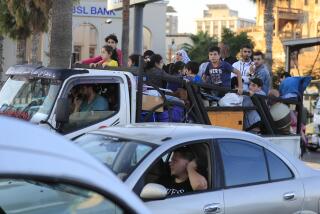Syria says it has chased rebels from Damascusâ Midan neighborhood
BEIRUT â Fighting raged for a sixth consecutive day in Damascus, opposition activists said Friday, even as Syriaâs government declared that it had routed rebels from the capitalâs Midan district, site of intense battles earlier in the week.
The United Nations, meantime, said as many as 30,000 people had fled from Syria to Lebanon during the previous 48 hours, many of them fleeing the heaviest fighting to date in Damascus.
The unrest in Syria has sent more than 200,000 people into exile â mostly to neighboring Lebanon, Turkey and Jordan â and displaced 1 million residents within Syria, according to U.N. figures and other estimates.
Syrian state television said Friday government forces had âcleanedâ the capitalâs Midan neighborhood of âterrorists,â the governmentâs customary term for armed insurgents seeking to oust President Bashar Assad.
The rebels labeled their actions in Midan as a âtactical retreat,â the latest in a series of such pullbacks in the face of superior firepower.
Opposition activists reported that more than 100 people across the nation were killed in violence Friday. A day earlier, believed to the bloodiest day of the rebellion, almost 300 died, according to the Syrian Observatory for Human Rights, a Britain-based activist group.
Each side in the Syrian conflict has accused the other of inflating casualty counts for political reasons. The government has severely restricted the access of foreign journalists, making it difficult to verify the claims.
Also on Friday, the United Nations Security Council agreed to extend for 30 days the U.N. observer mission in Syria. The period could be extended if the U.N. certifies that the violence has abated and that heavy weapons are no longer being used against population centers.
The mission, with 300 observers and 90 civilian personnel, has largely been suspended since last month because of concern for the safety of its personnel. Even before the suspension, the observers had been unable to do much more than confirm massacres and document the bloody aftermath of battles they were helpless to prevent.
Meanwhile, official media said Friday that Gen. Hisham Ikhtiyar, chief of national security, became the fourth high-ranking official to die of wounds suffered in the bombing Wednesday of a national security compound in Damascus.
Gen. Asef Shawkat, the brother-in-law of the president, was killed in the blast. Interior Minister Maj. Mohammed Ibrahim Shaar was injured, the government said, but his condition has not been publicly disclosed.
Taking responsibility for the bombing were two groups fighting under the umbrella of the rebel Free Syrian Army, a collection of militias including military defectors and others fighters seeking to oust Assad.
The bombing rattled the core of Assadâs security establishment and seemed to shift momentum in the more than 16-month conflict to the side of the insurgents, who are armed mostly with rifles, rocket-propelled grenades and homemade bombs.
Although the rebels have made many gains and have seized huge swaths of territory, the governmentâs superior arms usually have been sufficient to push insurgents back during aggressive counterattacks.
That was apparently the case Friday in Damascusâ Midan district, close to the walls of the Old City and long a center of opposition to Assad.
In Midan, the opposition reportedly declared a âtactical retreat,â a move employed over and over again in a war where territory has frequently been won by the rebels and then relinquished in the face of superior government firepower.
More to Read
Sign up for Essential California
The most important California stories and recommendations in your inbox every morning.
You may occasionally receive promotional content from the Los Angeles Times.










